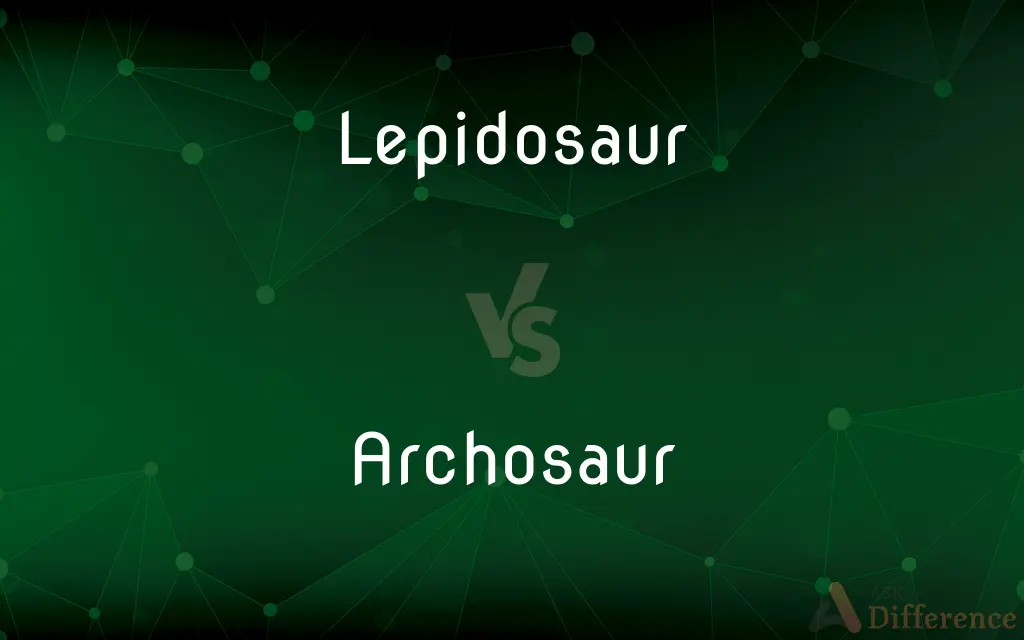Lepidosaur vs. Archosaur — What's the Difference?
Edited by Tayyaba Rehman — By Maham Liaqat — Updated on March 18, 2024
Lepidosaurs are reptiles within the Lepidosauria order, including snakes, lizards, and tuataras, whereas Archosaurs are a group encompassing birds, crocodiles, dinosaurs, and their extinct relatives.

Difference Between Lepidosaur and Archosaur
Table of Contents
ADVERTISEMENT
Key Differences
Lepidosaurs are characterized by their unique skin covered in scales or scutes, a feature that provides them with protection and aids in moisture retention. This group is notable for its incredible diversity, with species adapted to a wide range of habitats across the globe. In contrast, Archosaurs, distinguished by their socketed teeth, mandibular fenestrae, and other unique skeletal traits, have dominated various ecological niches from the Triassic period to the present, including both terrestrial and aerial environments.
The evolutionary lineage of Lepidosaurs dates back to the late Permian period, showcasing a long history of adaptation and survival. They possess a distinctive skeletal feature known as the lepidosaurian skull, which allows for a high degree of cranial kinesis (movement of skull bones relative to each other), benefiting their feeding strategies. Archosaurs, on the other hand, originated in the early Triassic period and have evolved into some of the largest and most formidable creatures in Earth's history, including the non-avian dinosaurs and modern crocodilians.
Lepidosaurs primarily reproduce through egg-laying, though some species exhibit viviparity (giving birth to live young), showcasing a significant range in reproductive strategies. Archosaurs, conversely, are primarily oviparous (egg-laying), with birds and some extinct dinosaurs developing sophisticated nesting behaviors and parental care strategies that have contributed to their success across various epochs.
In terms of ecological roles, Lepidosaurs, such as lizards and snakes, often occupy roles as predators and prey within their ecosystems, contributing to the control of insect populations and serving as food sources for larger predators. Archosaurs, including modern birds and crocodiles, occupy a broad spectrum of ecological niches, ranging from apex predators to scavengers and herbivores, significantly impacting the biodiversity and trophic dynamics of their habitats.
The study of Lepidosaurs and Archosaurs not only illuminates the diversity and adaptability of reptiles throughout Earth's history but also provides insights into the evolutionary processes that have shaped life on our planet. By understanding the characteristics and ecological roles of these groups, scientists can gain a deeper appreciation of biodiversity and the importance of conservation efforts in preserving these ancient lineages.
ADVERTISEMENT
Comparison Chart
Key Groups
Snakes, lizards, tuataras
Birds, crocodiles, dinosaurs
Distinctive Features
Scales or scutes, lepidosaurian skull for cranial kinesis
Socketed teeth, mandibular fenestrae
Evolutionary Origin
Late Permian period
Early Triassic period
Reproduction
Mostly oviparous, some viviparous
Primarily oviparous, with varying levels of parental care
Ecological Roles
Predators, prey, control of insect populations
Apex predators, scavengers, herbivores, diverse ecological impacts
Significance
Illustrate adaptation and survival across diverse habitats
Show dominance in ecological niches from the Triassic to present
Compare with Definitions
Lepidosaur
Adapted to diverse habitats with varying reproductive strategies.
Some snakes exhibit viviparity, giving birth to live young in harsh environments.
Archosaur
A group including birds, crocodiles, and their extinct relatives like dinosaurs.
Birds, the most diverse group of living archosaurs, occupy habitats worldwide.
Lepidosaur
Evolved in the late Permian, demonstrating significant evolutionary resilience.
The tuatara, a lepidosaur, is often referred to as a living fossil.
Archosaur
Evolved to dominate terrestrial and aerial niches.
Pterosaurs, extinct flying archosaurs, were the first vertebrates to achieve powered flight.
Lepidosaur
Reptiles within the Lepidosauria order, featuring scales or scutes.
Lizards thrive in various climates, from deserts to forests.
Archosaur
Includes the largest animals ever to exist on land and the masters of the sky.
The diversity of birds, from hummingbirds to ostriches, highlights the evolutionary success of archosaurs.
Lepidosaur
Exhibits a wide range of forms and behaviors, from terrestrial to arboreal.
Chameleons, known for their color-changing ability, are highly specialized lepidosaurs.
Archosaur
Originated in the early Triassic, leading to dinosaurs and modern birds.
Dinosaurs once represented the dominant terrestrial vertebrates.
Lepidosaur
Serve both as predators and prey, maintaining ecosystem balance.
Snakes control rodent populations, impacting agricultural pest management.
Archosaur
Range from apex predators to herbivores, influencing biodiversity.
Crocodiles are key apex predators in aquatic ecosystems.
Lepidosaur
(zoology) A member of the Lepidosauria, reptiles with overlapping scales
Archosaur
Archosauria (lit. 'ruling reptiles') is a clade of diapsids, with birds and crocodilians as the only living representatives. Archosaurs are broadly classified as reptiles, in the cladistic sense of term which includes birds.
Archosaur
Any of various vertebrates of the group Archosauria, having a single opening in each side of the skull in front of the eye socket, and including the dinosaurs, birds, pterosaurs, and modern crocodilians.
Archosaur
A reptile of the taxon Archosauria, which includes modern crocodilians and birds, as well as the extinct pterosaurs, non-avian dinosaurs and other taxa.
Archosaur
Extinct reptiles including: dinosaurs; plesiosaurs; pterosaurs; ichthyosaurs; thecodonts
Common Curiosities
What are the main differences between Lepidosaurs and Archosaurs?
Lepidosaurs are defined by their scales and specific skull structure, while Archosaurs are characterized by their unique dental and skeletal features, including socketed teeth.
Do all Archosaurs lay eggs?
Yes, all known Archosaurs lay eggs, though their nesting behaviors and parental care can vary significantly, especially among birds.
How do Lepidosaurs and Archosaurs contribute to their ecosystems?
Lepidosaurs often control pest populations and serve as prey, while Archosaurs occupy a wide range of ecological niches, from apex predators to herbivores, impacting ecosystem dynamics.
Can Lepidosaurs fly?
No, flight is not a characteristic of Lepidosaurs; this ability is seen in certain Archosaurs, such as birds and extinct pterosaurs.
Are dinosaurs considered Lepidosaurs?
No, dinosaurs are categorized within the Archosaurs, separate from Lepidosaurs like snakes and lizards.
How does the diversity of modern birds compare to that of their Archosaur ancestors?
Modern birds, as descendants of theropod dinosaurs (a group of Archosaurs), exhibit incredible diversity in form, function, and behavior, far exceeding the diversity of their dinosaurian ancestors. This diversification reflects their adaptation to a wide range of ecological niches around the world.
How do the reproductive strategies of Lepidosaurs and Archosaurs differ?
Lepidosaurs exhibit a mix of oviparous (egg-laying) and viviparous (live-bearing) reproductive strategies, with some species adapting to specific environmental conditions. Archosaurs are primarily oviparous, with birds and some dinosaurs exhibiting advanced forms of parental care, such as nest building and feeding offspring.
Why are tuataras considered special among Lepidosaurs?
Tuataras are considered special because they represent an ancient lineage of Lepidosaurs that has remained relatively unchanged for millions of years, providing unique insights into the evolutionary history of reptiles.
What role did Archosaurs play during the Mesozoic Era?
During the Mesozoic Era, also known as the Age of Dinosaurs, Archosaurs were the dominant vertebrates on land, in the air, and in water, occupying a vast array of ecological niches and shaping the biological landscape of the period.
What evolutionary adaptations have allowed Crocodilians to survive since the age of dinosaurs?
Crocodilians, a group within Archosaurs, have survived since the age of dinosaurs due to a combination of physiological and behavioral adaptations, including a robust immune system, efficient metabolism, strong parental care, and the ability to live in a variety of aquatic habitats, making them successful apex predators.
Share Your Discovery

Previous Comparison
Spend vs. Expend
Next Comparison
Report vs. AccountAuthor Spotlight
Written by
Maham LiaqatEdited by
Tayyaba RehmanTayyaba Rehman is a distinguished writer, currently serving as a primary contributor to askdifference.com. As a researcher in semantics and etymology, Tayyaba's passion for the complexity of languages and their distinctions has found a perfect home on the platform. Tayyaba delves into the intricacies of language, distinguishing between commonly confused words and phrases, thereby providing clarity for readers worldwide.














































